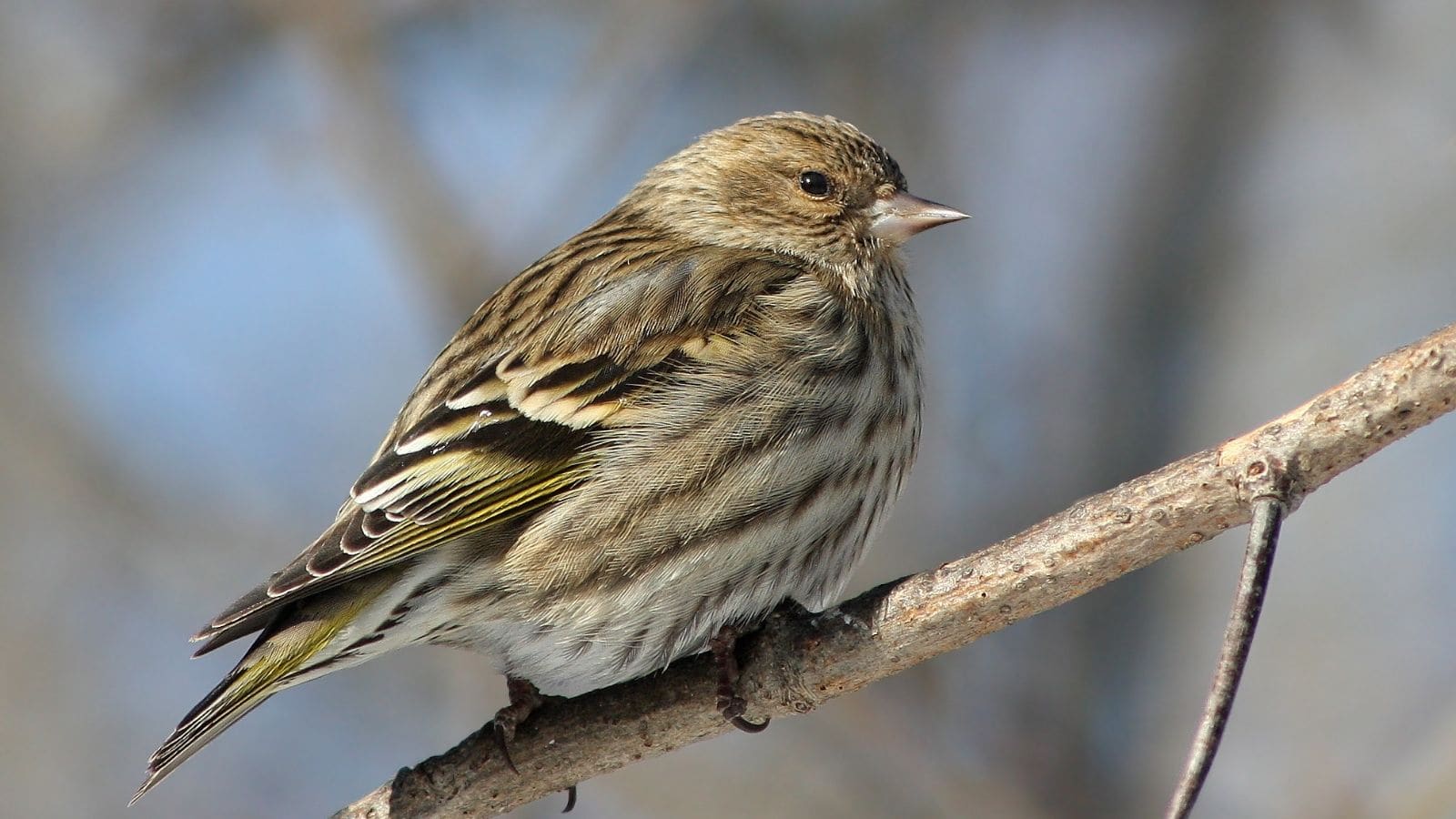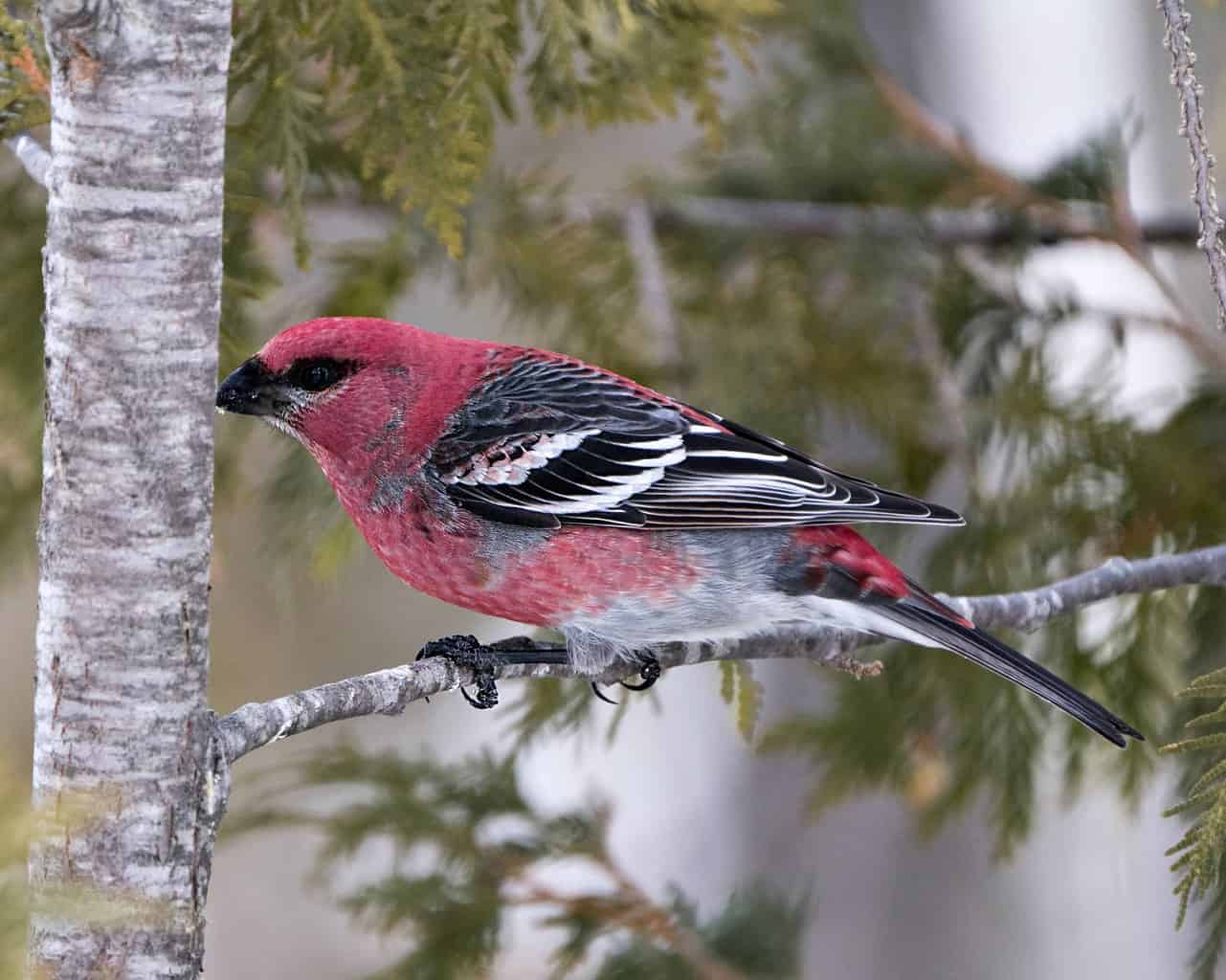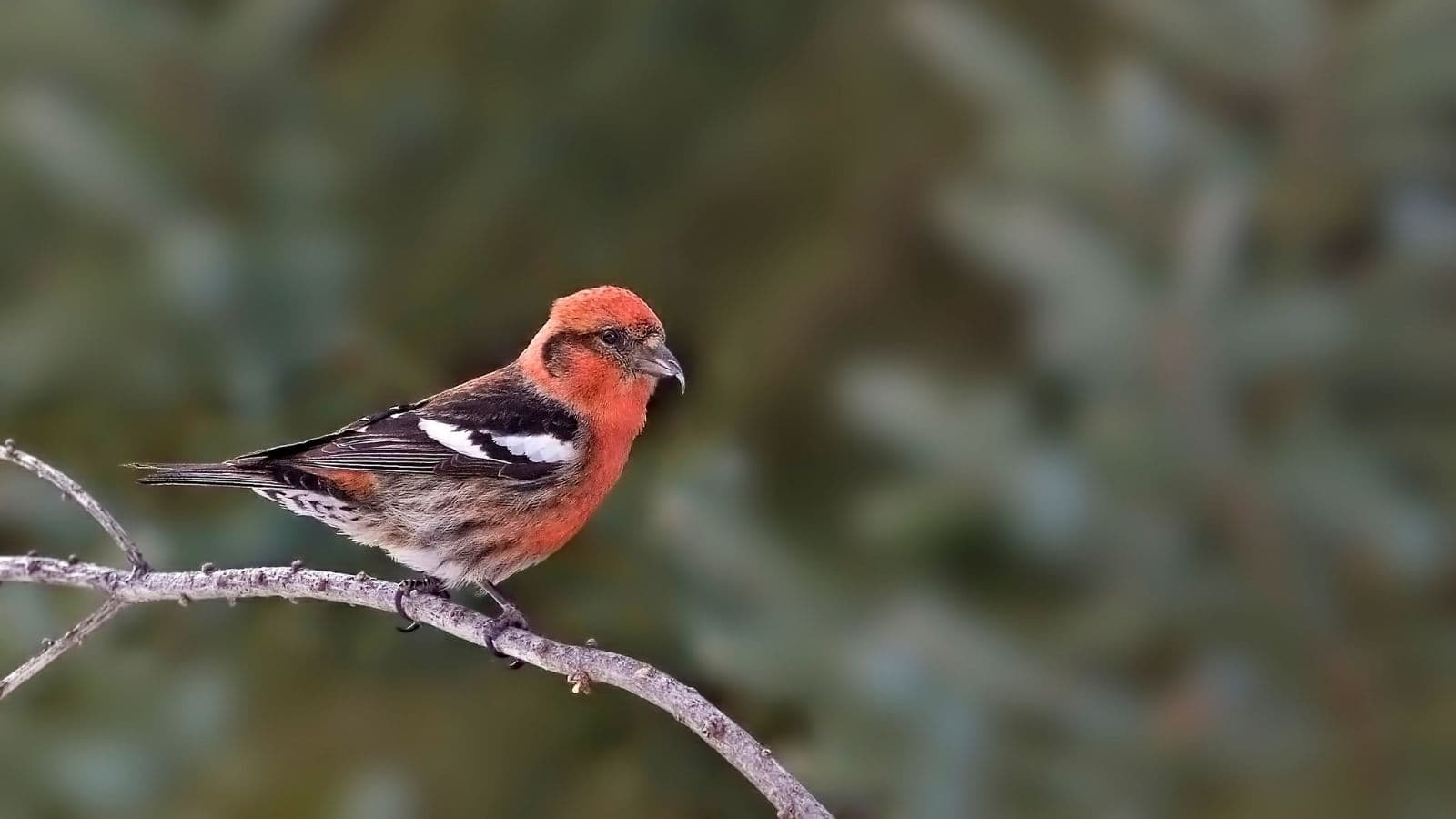Did you know that Maine is not only the most sparsely populated state east of the Mississippi River but also the most forested state in the entire USA?
This is great news for forest-loving birds, and there have been nearly 500 species of bird recorded here since records began.
Among them are the finches, a fascinating family of birds with stout bills, notched tails, and pointed wings. Because many finch species are forest specialists, foraging heavily on coniferous and deciduous tree seeds, Maine’s leafy landscapes often serve them well.
When they’re not busy feeding in the tree canopy, finches love to descend to residential gardens to fuel up at backyard bird feeders. Platform feeders and tube feeders are two of the most appropriate types for finches that love to feast on an oil-rich variety of seeds.
If you’re eager to learn all about the beautiful purple finches, siskins, crossbills, and grosbeaks that live here, you’ve come to the right place. Our list starts with the most common, everyday finches, and ends with the rarest of nomadic wanderers.
Finches in Maine, Starting With the Most Common
American Goldfinch

- Scientific Name: Spinus tristis
- Length: 4.3-5.1 in (11-13 cm)
- Weight: 0.4-0.7 oz (11-20 g)
- Wingspan: 7.5-8.7 in (19-22 cm)
The most common finch in North America is also the most frequently seen in Maine. American goldfinches are ticked off on more than 40% of birdwatcher reports during the summer, and just under 30% of winter checklists.
American goldfinches go through a dramatic color change every spring and fall. In March, male birds turn from a drab gray-dull yellow to a brilliant gold – a gladdening sign that spring is coming! Also, look out for their black forehead and black and white wings.
One of the most familiar backyard birds, American goldfinches are ever-present at bird feeders during the winter when they love to feed on sunflower seeds and nyjer (thistle seeds). Special ‘thistle feeders’ have been developed specifically for attracting goldfinches and some of their relatives.
American goldfinches begin nesting later than other birds, especially this far north. They wait until milkweeds and thistles produce their fluffy seed so they can weave them into their nests as well as feed them to their young!
House Finch

- Scientific Name: Haemorhous mexicanus
- Length: 5.1-5.5 in (13-14 cm)
- Weight: 0.6-0.9 oz (16-27 g)
- Wingspan: 7.9-9.8 in (20-25 cm)
House finches are fairly common birds year-round in Maine, although they’re reported slightly more often here in winter than in summer.
Pretty birds, house finches are originally from the Western USA but were caged and marketed as ‘Hollywood finches’ to sell in the East. Exotic pet laws in the 1940s saw many owners and dealers release the birds, and they now roam wild all over the country.
Perhaps the spread of the house finch was already inevitable because of how well they do near human habitation. House finches thrive around farms and suburban neighborhoods alike, and often build their nests in buildings and ledges.
While male house finches are known for their bright red crowns and chests, females are entirely brown and gray.
Both sexes could get confused with their relatives the purple finch, but purple finch males have a red wash over much more of their body, and females have more pronounced, darker streaks than those of the house finch.
Purple Finch

- Scientific Name: Haemorhous purpureus
- Length: 4.7-6.3 in (12-16 cm)
- Weight: 0.6-1.1 oz (18-32 g)
- Wingspan: 8.7-10.2 in (22-26 cm)
Purple finches are only slightly less common than house finches in Maine and are reported by around 13% of bird watchers in summer, and just over 2% in winter.
The Northeast is one of the few regions where purple finches remain common birds year-round. Most of the Eastern subspecies breed in Canada but then fly to the Midwest and the Southeast for winter.
Purple finches perform a very entertaining courtship dance where the male hops around near the female with drooping wings and a puffed-out chest, sometimes with nesting material in his bill! He then vibrates his wings until he rises slightly into the air to impress her.
Purple finches were once more common in New England, but competition from introduced species has weakened their populations. Both house sparrows and more latterly, house finches often outcompete them for vital resources.
Pine Siskin

- Scientific Name: Spinus Pinus
- Length: 4.3-5.5 in (11-14 cm)
- Weight: 0.4-0.6 oz (12-18 g)
- Wingspan: 7.1-8.7 in (18-22 cm)
According to Sibley’s Guide to Birds, the pine siskin is the only finch species that can be found in every state of mainland USA. Traveling from Alaska to Mexico, these birds move around in large flocks, searching for tree seeds and insects to eat.
- Sibley Guide To Birds, 2nd Ed
- Sibley, David Allen (Author)
- English (Publication Language)
Last update on 2024-04-27 / Affiliate links / Images from Amazon Product Advertising API
Pine siskins are in the same genus as the goldfinches and often mix with them in flocks. They can be difficult to tell apart in winter when all birds have duller plumage, but siskins have more pointed bills and pronounced brown streaks compared with the rest.
Pine siskins appear on an average of 2% of summer checklists and 3% during the winter, but there can be considerable variation between years according to how much food is available.
These nomadic birds change their breeding grounds from year to year, nesting in loose colonies or as isolated pairs. Nests are usually well hidden in conifers on horizontal branches well away from the main trunk.
Common Redpoll

- Scientific Name: Acanthis flammea
- Length: 4.7-5.5 in (12-14 cm)
- Weight: 0.4-0.7 oz (11-20 g)
- Wingspan: 7.5-8.7 in (19-22 cm)
Common redpolls are one of the hardiest small birds on earth, so it’s not surprising that they spend much of their lives at Northerly latitudes. Even Maine is well south of their Northerly breeding grounds, meaning you’ll only see redpolls here in winter.
Between mid-October and May, there is usually a significant population of redpolls in Maine, and it can be fun trying to spot them as they move noisily through the tree canopy in search of food.
Both male and female redpolls have red caps, and males also have a deep pink chest. The rest of their body consists of brown and gray streaks. The only other member of the finch family you might confuse them with is the hoary redpoll, which is rarely seen in Maine.
You can get a closer look at redpolls by feeding them sunflower seeds and nyjer seeds at your platform feeders and tube feeders. These birds can eat almost half of their body weight in a day, and even store seeds in their throat to digest later!
Pine Grosbeak

- Scientific Name: Pinicola enucleator
- Length: 7.9-9.8 in (20-25 cm)
- Weight: 2.01 oz (57 g)
- Wingspan: 13.0 in (33 cm)
Maine is the only state on the Eastern Seaboard that’s lucky enough to host a breeding population of pine grosbeak. Even here, however, the largest finch in the world only nests in the northerly fringes of the state, in coniferous forests.
In the rest of Maine, residents have to wait until ‘irruption years’ for significant numbers of these birds to appear. One such year was in 2019 when flocks of them scoured New England in search of the rowan berries and crab apples that they adore.
Pine grosbeaks are spectacular-looking birds. Males are red and dark gray and females are gray with green or russet backs. Both sexes have long, notched tails, stout curved bills, and white wing bars.
Like crossbills, pine grosbeaks can be entertaining to watch. If you spot them flying between fruit trees, take the time to stop and observe their wonderfully energetic, acrobatic style of feeding.
Evening Grosbeak

- Scientific Name: Hesperiphona vespertina
- Length: 6.3 to 8.7 in (16 to 22 cm)
- Weight: 1.37 to 3.04 oz (38.7 to 86.1 g)
- Wingspan: 12 to 14 in (30 to 36 cm)
Only slightly smaller than the pine grosbeak is the evening grosbeak. They also have a small breeding population in Northern Maine, but these striking birds are more common here in winter than in summer.
Evening grosbeaks weren’t always seen in New England, however. In the 1800s, they were uncommon east of the Rocky Mountains but reached New England by 1911. It’s thought that their eastern expansion could be due to the growing number of box elder trees which provide reliable sustenance for them.
It can be difficult to observe evening grosbeaks, as they usually fly above the forest canopy and perch at the tops of tall trees. Backyard feeders are one of the best ways to get a closer look at them, and they’ll also sometimes visit gardens to feed on maple buds.
Evening grosbeaks are relatively long-lived finches. The oldest recorded specimen was a male and had aged 16 years since he was first banded in 1959.
White-Winged Crossbill

- Scientific Name: Loxia leucoptera
- Length: 5.9-6.7 in (15-17 cm)
- Weight: 0.8-0.9 oz (24-26 g)
- Wingspan: 10.2-11.0 in (26-28 cm)
Maine is one the few states where white-winged crossbills (aka. two-barred crossbill) can be seen throughout the year. While they do visit other northerly states during the winter, there are few places in the US where you can find them in the warmer months.
With its cold climate and dense coniferous forest cover, Maine offers a rare refuge for these forest-dwelling birds that are almost never seen far from the conifers they rely on for food.
Using their twisted bills, crossbills can prize open the spruce, fir, and pine cones that are found in Maine before any other birds can.
Bizarrely, both crossbills are some of the only bird species that can breed at any time of year, whenever there’s a plentiful food supply! Nests are made from twigs, grass, moss, and lichen and females can lay up to five eggs in each brood.
Red Crossbill

- Scientific Name: Loxia curvirostra
- Length: 5.5-6.5 in (14-17 cm)
- Weight: 1.4 oz (40 g)
- Wingspan: 10-10.75 in (25-27 cm)
A close cousin of the white-winged crossbill is the red crossbill. While these two species are similar in many ways, the red crossbill lacks white patches on its wings and tends to be more of a solid build than its relative.
Red crossbills also have a larger international range than white-winged crossbills. While their relatives are strictly northern birds, red crossbills will sometimes venture to Central America, Southeast Asia, and even North Africa!
Both species of crossbill are a delight to observe and are often compared to parrots. With their bright and beautiful colors and tame character, it’s not unusual to see them hanging upside down, feeding among conifer trees within a stone’s throw of a birdwatcher.
Red crossbills are sometimes seen ingesting salt and grit along roadsides and cattle feeders. It’s thought that these could be used as a digestive aid and mineral source for these birds that have an otherwise limited diet, mainly consisting of conifer seeds.
Hoary Redpoll

- Scientific Name: Acanthis hornemanni
- Length: 4.7-5.5 in (12-14 cm)
- Weight: 0.4-0.7 oz (11-20 g)
- Wingspan: 8.5-9.25 in (22-23 cm)
The hoary redpoll (or ‘arctic redpoll’) is the rarer cousin of the common redpoll and is very seldom seen in Maine. They only make it onto one in a thousand birdwatcher’s reports during the winter and are absent entirely during the summer.
This is to be expected since hoary redpolls are one of the most northerly dwelling species of bird on the continent. Rarely entering the United States at all, these hardy critters feel more at home in the arctic tundra.
Seen from Alaska to Siberia, Scandinavia, and Greenland, hoary redpolls are known to dig themselves into snow tunnels to escape the coldest weather. A miraculous lifestyle for a bird that’s so small!
Hoary redpolls are very difficult to tell apart from common redpolls and even have identical calls and songs. It would take a very discerning birdwatcher to notice the slightly paler, fluffier, and smaller-billed appearance than their cousins that they often flock with.
Two That Got Away
As a seaboard state on the cusp of different climate zones, Maine receives its fair share of ‘blow-ins’ – bird species that turn up here accidentally every few years.
Even rarer than any of the species listed above, two more beautiful finches make a very occasional appearance here. The lesser goldfinch and Eurasian siskin have both been recorded in Maine, although sightings are few and far between.
If you do spot either of these finch species in Maine, try to get a photo and report it to the Maine Audubon bird-watching website.
Conclusion
Conveniently positioned between summer and winter grounds of several species, with extensive areas of deciduous and coniferous forests, Maine is a mecca for finches.
Whether you’re watching a male purple finch bouncing into his courtship dance or catching a precious glimpse of a mighty pine grosbeak gleaning an apple tree, there are endless opportunities to enjoy this diverse family of birds in The Pine Tree State.
Finches make up just a few of the 470 bird species that have been recorded in Maine, so why not head over to our Birder’s Guide to Maine to become acquainted with some of the others?

